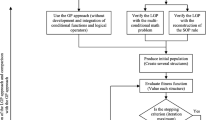Abstract
Conventional mathematical programming methods, such as linear programming, non linear programming, dynamic programming and integer programming have been used to solve the cost optimization problem for regional wastewater treatment systems. In this study, a river water quality management model was developed through the integration of a genetic algorithm (GA). This model was applied to a river system contaminated by three determined discharge sources to achieve the water quality goals and wastewater treatment cost optimization in the river basin. The genetic algorithm solution, described the treatment plant efficiency, such that the cost of wastewater treatment for the entire river basin is minimized while the water quality constraints in each reach are satisfied. This study showed that genetic algorithm can be applied for river water quality modeling studies as an alternative to the present methods.
Similar content being viewed by others
References
Aras E (2003) Stepped spillway aeration on dams and effects in stream reaeration (In Turkish), M.Sc. Thesis, Karadeniz (Black Sea) Technical University, Department of Civil Engineering, Trabzon, Turkey
Berkun M (1982). Effects of inorganic metal toxicity on BOD – I, Methods for the investigation of BOD parameters—II. Water Res 16: 559–564
Berkun M (2005). Effects of Ni, Cr, Hg, Cu, Zn, Al on the dissolved oxygen balance of streams. Chemosphere 59: 207–215
Cho JH, Sung KS and Ha SR (2004). A river quality management model for optimizing regional wastewater treatment using a genetic algorithm. J Environ Manage 73: 229–242
Crowe AM, McClean CJ and Cresser MS (2006). An application of genetic algorithms to the robust estimation of soil organic and mineral fraction densities. Environ Model Software 21: 1503–1507
Cutrera G, Manfredi L, Valle EC and Gonzales FJ (1999). On the determination of the kinetic parameters for the BOD test. Water SA 25(3): 377–379
Downing K (1998). Using evolutionary computational techniques in environmental modeling. Environ Model Software 13: 519–528
Fujiwara O (1990). Preliminary optimal design model for wastewater treatment plant. J. Environ. Eng. ASCE 116(1): 206–210
Goldberg DE (1989). Genetic Algorithm in the search, optimization and machine learning. Addison-Wesley Publishing Company, New York
Gupta I, Gupta A and Khanna P (1999). Genetic algorithm for optimization of water distribution systems. Environ Model Software 14: 437–446
Klemetson SL and Grenny WJ (1985). Dynamic optimization of regional wastewater treatment systems. J Water Pollut Control Federation 57(2): 128–134
Marske DM and Polkowski LB (1972). Evaluation of methods for estimating biochemical oxygen demand methods. J Water Pollut Control Fed 44: 1987
Mohamed M (2000) Comparison of field measurement to predicted reaeration coefficients, k2, in the application of water quality model, Qual2e, to a tropical river, PhD thesis, Colorado State University, Fort Collins, Colorado
Pelletier GJ, Chapra SC and Tao H (2006). QUAL2Kw- A framework for modeling water quality in streams and rivers using a genetic algorithm for calibration. Environ Model Software 21(3): 419–425
Revelle CS, Loucks DP and Lynn WR (1968). Linear programming applied to water quality management. Water Resour Res 4(1): 1–9
Streeter HW, Phelps EB (1925) A study of the pollution and natural purification of Ohio river, III. Factors concerned in the phenomena of oxidation and reaeration. Bulletin 146. Public Health Service, Washington, DC, USA
Tebbutt THY and Berkun M (1976). Respirometric determination of BOD. Water Res 10(1976): 613–617
Toğan V (2004) Size and shape optimization of trusses under dead and moving loads using genetic algorithms (in Turkish). M.Sc. thesis. Karadeniz Technical University
Toğan V and Daloğlu A (2006). Optimization of 3d trusses with adaptive approach in genetic algorithms. Eng Struct 28: 1019–1027
Wang OJ (1997). Using genetic algorithms to optimize model parameters. Environ Model Software 12(1): 27–34
Author information
Authors and Affiliations
Corresponding author
Rights and permissions
About this article
Cite this article
Aras, E., Toğan, V. & Berkun, M. River water quality management model using genetic algorithm. Environ Fluid Mech 7, 439–450 (2007). https://doi.org/10.1007/s10652-007-9037-4
Received:
Accepted:
Published:
Issue Date:
DOI: https://doi.org/10.1007/s10652-007-9037-4




